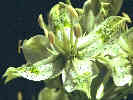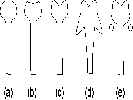 Eastern Mojave Vegetation
Eastern Mojave Vegetation
Tom Schweich
 Eastern Mojave Vegetation
Eastern Mojave Vegetation
| Autecology of Desert Elkweed Frasera albomarginata S. Watson (Syn: Swertia a.) Gentianaceae in the American Southwest (Continued) |
|
Tom Schweich |

Topics in this Article: Introduction Literature Review Field Work and Methods Results Taxonomy Distribution Growth Habits Relationships to Soils and Other Plants Life History Discussion Summary Literature Cited Appendix A -- Field Data Communications Received. |
|
|||||||||||||||||||||||||||||||||||||||||
|
|
Taxonomy | |||||||||||||||||||||||||||||||||||||||||
| The type specimen of Frasera albomarginata Wats. is at US. There is an isotype at NY, for which an image is available online. | ||||||||||||||||||||||||||||||||||||||||||
|
Literature Cited:
|
The labels on the vouchers state that the collection locality was "S. E. Utah." However, Watson's original description of Frasera albomarginata Wats. gives the locality as "Near St. George in Southern Utah (Dr. Palmer, 1870)." Saint George is, of course, in southwestern Utah.
| |||||||||||||||||||||||||||||||||||||||||
|
Literature Cited:
Locations: Saint George. |
The type specimen of Frasera albomarginata (S. E. Utah, 1870, Palmer (US)) is an entirely glabrous plant, as was indicated in Watson's description of the species. Specimens of the species examined in the University and Jepson Herbaria (University of California, Berkeley) include the type species and one variety, S. a. var. induta. Although, this variety is not recognized in Hickman (1993). | |||||||||||||||||||||||||||||||||||||||||
|
Literature Cited:
|
The first description of Frasera was by Thomas Walter (1788) in his Flora Caroliniana. We are very fortunate to see the original publication online at URL:
http://www.botanicus.org/title/b12073714#. Thanks also to Missouri Botanical Garden for
making the book and online image available.
I have tried to give an English translation, and am open to corrections.
| |||||||||||||||||||||||||||||||||||||||||
|
Literature Cited:
|
||||||||||||||||||||||||||||||||||||||||||
|
Literature Cited:
|
||||||||||||||||||||||||||||||||||||||||||
|
Literature Cited:
|
||||||||||||||||||||||||||||||||||||||||||
| Variety albomarginata is the most common expression. It is found mostly on dry, sagebrush foothills and alluvial fans, extending into the pinyon-juniper zone, mostly from 4,500-7,600 ft. | ||||||||||||||||||||||||||||||||||||||||||
|
Literature Cited:
Locations: Clark Canyon. Harris Springs. Spring Mountains. |
Variety induta (Tidestrom) Card, Ann. Mo. Bot. Gard., 18:275. 1931. is a rare expression in Nevada, ranging from Charleston Peak, Clark Canyon, Harris Springs and elsewhere in the Spring Mountains, Clark County; to southern Nye County. It is found in dry habitats, often with Cercocarpus and pinyon-juniper but extending into the yellow pine zone from 5,000-8,000 ft. (Kartesz, 1988). Kartesz states the variety is easily separated from the above expression by its glandular-hairy infloresence and unique foveae. | |||||||||||||||||||||||||||||||||||||||||
|
Other articles:
|
183 | 184Most of my collections of the species are from the eastern Mojave. | ||||||||||||||||||||||||||||||||||||||||
 Frasera albomarginata flower. Frasera albomarginata flower.
|
The nectaries in Frasera are prominently placed on the corolla lobes, and called fovea. This can be seen in the photograph of the flower at left. Fovea is a Latin word for "small pit" and defined as, "a shallow cuplike depression or pit, as in a bone (Websters II, 1984)." Since we are speaking good Latin here, the plural is "foveae." The foveae seem to be prospective characteristics for distinguishing between subspecies of F. albomarginata and among species of the genus Frasera. In my examination of herbarium specimens of F. albomarginata, there seem to be five different shapes of foveae. These are diagrammed below. | |||||||||||||||||||||||||||||||||||||||||
 Fovae. Fovae.
|
Adapting some of the terminology used in describing leaf bases and tips, these nectaries would be described as follows:
(a) nectary linear pit, 2-lobed at tip, lobes rounded.
|
|
I would like to be able to describe some sort of evolutionary order of increasing complexity and elaboration in the fovea from (a) to (e).
However, at this time, I'll have to leave that as a possible construct, awaiting a testable hypothesis and testing.
|
|
|
From my examination of herbarium specimens, I agree with separation of the variety induta on the character of glandular-hairy infloresence.
Although, I would express the character as puberulent upper stems and bracts.
I don't, however, find that the shapes of the foveae are distinctive for the variety.
|
|
|
I identify the eastern Mojave specimens as S. a.
var. albomarginata because the stems and bracts are glabrous,
not puberulent, and the foveae are not unique.
|
|
Literature Cited:
Locations: Charleston Peak. Spring Mountains.
|
Kartesz (1988) also states that var. induta is the westernmost expression of the species,
with the type from rocky places in the pinyon and yellow pine belts, Spring (Charleston) Mountains, Clark County. This may be true. My eastern Mojave locations are just east of south
of the Spring Mountains and Charleston Peak. Unless there are occurrences of F. albomarginata west of the Mid Hills or Providence Mountains, then the Spring Mountains are the
westernmost location for the species.
|
|
Literature Cited:
|
Both this species and the closely related F. [Swertia] puberulenta are most likely evolved from Frasera speciosa (Kartesz, 1988).
|
|
Literature Cited:
Other articles:
|
Chassot et al. (2001) study of the phylogeny of Swertia showed that Swertia, as currently defined in regional floras or otherwise (e.g., Pringle, 1990), is not a monophyletic taxon when considering the molecular data. Rather, it is a strongly paraphyletic stem group. Their consensus trees are shown at left.
| My unschooled interpretation is that a number of somewhat related taxa that look similar have been lumped into Swertia. However, new molecular data shows many of them are more closely related genetically to other taxa in Gentianaceae than to other Swertia. This introduces confusion as to what Swertia really is and, therefore, what belongs in Swertia and what does not. Chassot et al. (2001) state that the generic concept of Swertia has never been viable, mainly because macromorphological characters for not exhibit clear enough patterns to unambiguously justify taxonomic units. That sounds to me like the argument that Pringle (1990) makes to keep Frasera in Swertia, is also used by Chassot, et al. (2001) to justify blowing up the genus Swertia. However, regardless of whether there is a further breakup of Swertia, Frasera does not belong there, and it should be recognized at the generic rank, i.e., as a genus. In California, Swertia perennis L. should remain in Swertia. Frasera albomarginata (S. Watson) Kuntze should be Frasera albomarginata S. Watson, and Swertia radiata (Kellogg) Kuntze should be Frasera speciosa Griesb.
|
|
[Previous Page]
[Next Page]
|
If you have a question or a comment you may write to me at:
tas4@schweich.com
I sometimes post interesting questions in my FAQ, but I never disclose your full name or address.
|
|
Date and time this article was prepared: 4/27/2024 3:29:43 PM | ||||||||||||||||||